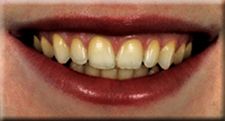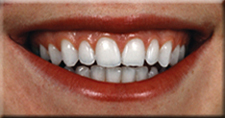Dear Patient,

Coloration of teeth has always been an important feature of one's smile. Primitive cultures manipulated
tooth color in many ways to achieve a desired effect. That effect often included changing tooth color
to black, blue, green and other unusual colors. Other ancient people valued the importance of white
teeth so much that they darkened their lips and area around their eyes to make the teeth appear whiter
by contrast. Our culture obviously values light teeth, evidence is in posters and popular magazines.
Your smile is one of the most important aspects of how you present yourself to others and make you
"uniquely you".
Modern methods of whitening teeth are the product of many years of research and careful consideration
of the safest, most effective means of treating discolored teeth. Below we answer common questions and
concerns about tooth whitening. We hope this will demystify the tooth whitening process for you.
How Did my Teeth Get So Yellow?

There are many factors that lead to tooth discoloration.
Tooth color is a matter of inherited tendencies. Some
of us are born with the tendency for lighter teeth and
some teeth respond better to whitening than others.
The process of aging may produce discoloration. Stains
from foods such as coffee and tea accumulate on your
teeth over time. The tiny fractures and chips that occur
with aging collect stain more readily and enhance the
discoloration. Whitening can be helpful in treating the discoloration that ordinarily occurs with aging.
Some staining may be the result of the use of the antibiotic tetracycline or large amounts of
fluoride during the development of teeth. A tooth may become discolored because of disease or nerve
death caused by infection or trauma. These types of discoloration are usually permanent, but may
respond well to whitening.
How Does Whitening Work?

Your dentist will first check your teeth and gums to be sure that you begin the treatment in good
dental health. Then your dentist will take an impression of your teeth in order to provide you with
a custom-fit plastic tray. This custom tray holds a viscous peroxide gel against the tubulars of
your enamel before it is diluted by your saliva.
You will be provided with your tray, the whitening agent, and instructions on proper use. Following
the bleaching program your dentist recommends, you'll notice the results quickly, as the gel begins
to lighten your teeth.
How Long Will it Last?
Your own long term results vary depending on your habits and the foods you eat. Non-smokers who
don't drink coffee or tea see little or no change over five years. Based on those variables
some patients may require a "touch-up" treatment at regular intervals.
Is Bleaching Safe?
If performed properly, under the supervision of a dental professional, research has shown that
bleaching works without lasting damage to underlying dental tissues. The whitening process will
not affect your enamel, tooth structure, bonding or restorations. In fact, dentist supervised
whitening has been done for nearly a century, but has increased in popularity in recent years
as stained teeth are becoming less acceptable, and the process becoming more efficient and available.
Is There any Discomfort?
There is little, if any. Some patients might feel some tingling or stinging of the gums or the
appearance of small blanching. This is generally caused by the whitening agent coming in contact
with the soft tissue. This contact can be avoided by using trays made to fit your own unique mouth.
Also, overfilling the tooth trays can cause the agent to seep out the top and come in contact with
the gums, causing some tenderness. Extending treatment times past what is recommended does not
effectively whiten but instead dehydrates the teeth and can cause some discomfort. Such
sensitivities are minor and ceases shortly after discontinuing treatment.
What's the Difference Between Dentist-Supervised and
Over-the-Counter Treatments?
There are many differences, starting with the fact that your teeth and your own dental situation
are absolutely unique. Which is why the safety of your treatment requires a dentist's evaluation
and supervision. You'll also find that trays designed by a dentist will fit better and will
consequently expel far less bleaching gel that the unsupervised, over-the-counter, one-size-fits-all
treatment alternatives. Chemicals such as those found in bleaching products are most safely
applied while under the care of a dental professional using specialized equipment that will
protect surrounding tissue to the greatest degree.



